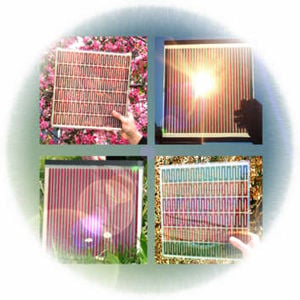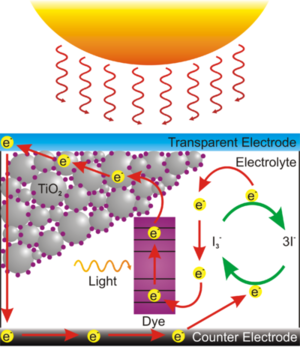
Dye-sensitized solar cells, or DSSCs, are a third generation[1] technology in the area of photovoltaics. They are classified as a type of thin-film solar cell,[2] meaning that they require only a small amount of material per cell compared to the first generation solar cells, making DSSCs lighter and more physically resilient than their first generation counterparts. They use a process similar to photosynthesis to produce electrical energy, making them an example of biomimicry.
Dye-sensitized solar cells are a promising technology because they are inexpensive and resilient, making them ideal for large scale and small scale applications.[3] However, they have lower efficiencies than most other types of solar cells, so they require more space than other types of solar cells to produce the same amount of electric energy. This disadvantage is offset by their low cost and greater resilience and flexibility.[4]
Background[edit | edit source]
Since the early 20th century, the most commonly researched types of solar cells were the crystalline silicon solar cell, which were generally very efficient but costly and difficult to produce. Because of the problems of high cost and difficulty in production with crystalline silicon cells, researchers developed the cheaper but less efficient thin-film cells. Dye-sensitized solar cells are one of the most promising types of thin-film solar cells.[5]
Dye-sensitized solar cells were invented by Michael Grätzel in 1991,[6] who won the Millennium Technology Prize in 2010 for his work in the area of DSSCs.[7] Since their invention, a great deal of work has been done to optimize the performance of DSSCs, such as finding their optimum parameters,[8] finding the most cost efficient dyes,[9] doping with various elements to improve dye functioning,[10][11] and running cells in tandem to improve efficiency.[12] The research done on DSSCs will likely increase their effectiveness while lowering their cost, making them a strong competitor to traditional crystalline silicon cells in the near future.[4]
Current state[edit | edit source]
Dye-sensitized solar cells have come into use gradually since their invention. DSSCs are fairly flexible, so they can be used for a wide variety of applications diverse applications ranging from large power plants covered in organic DSSCs (for picture and more information, see this article)[13] to DSSCs carried by soldiers to power their gear in the field.[4] DSSCs can also be used in homes very easily and subtly, appearing as singles on the roof or windows and walls on the side of the house.[14][4] Because DSSCs are based on a colored dye, they can be modified to blend in with their surroundings, urban or rural, to avoid becoming an eyesore. Also, DSSCs don't lose effectiveness at high temperature like traditional crystalline silicon cells do, making them ideal for hotter environments.[15]
The only major technical problem affecting DSSCs currently is their lack of chemical stability over time, which has slowed their commercial growth and application.[16] Much work is being done regarding this issue, and it is likely to become less of a problem in the near future.[17][18]
Chemistry[edit | edit source]
A dye-sensitized solar cell is similar to all other forms of solar cells in general functioning, as it absorbs sunlight to release electrons which provides electrical energy. For more information on the basic principles of solar cells, see Photovoltaics. What makes dye-sensitized solar cells unique from other types of photovoltaic cells is the use of a network of porous titanium dioxide nanoparticles covered with photosensitive dye, usually ruthenium-polypyridine dye[19] or some kind of organic dye.[20] The titanium dioxide acts as the anode and is separated from a platinum cathode by an electrolytic solution, typically iodide. When light strikes the dye, electrons are released and transported by the titanium dioxide's conduction band, creating a voltage difference between the two sides, similar to a battery. When the anode and cathode are connected, an electric current is generated between the cathode and the anode because of the voltage difference between the two. As long as the anode and cathode are connected and the cell is active, the voltage difference and current generate electric power, which can be used or fed into the existed grid. After reaching to the cathode side of the cell, the electrons pass though the electrolytic solution to the anode to replenish the dye and prepare it to absorb more sunlight.[21]

The overall conversion efficiency of DSSCs is usually around 5-11%,[22] which is lower than most other solar technology due to poorer absorption of light by most common dyes compared to crystalline silicon. However, DSSCs are quite efficient on the quantum level, as electrons released by the dye are usually absorbed by titanium dioxide and converted to useful energy. In practical applications, this fact means that generally, when the dye emits an electron, it will be usable as energy, instead of wasted recombining with the dye. Most other solar technologies have a lower quantum efficiencies, so their energetic electrons are more likely to be wasted than DSSCs.[23]
The process used by dye-sensitized solar cells is very similar to that used by plants in photosynthesis. Both processes use a photosensitive molecular dye (chlorophyll a and b for plants) to absorb light energy and release an electron to be transported and used for energy generation or storage. Because the processes are similar, dye-sensitized solar cells are considered a form of Biomimicry.
Next steps[edit | edit source]
Much work has yet to be done before dye-sensitized solar cells become widely produced and sold. Some of the problems with DSSCs are listed below.
Dye Degradation[edit | edit source]
The dyes in DSSCs tend to degrade over time, leading to decreased efficiency and a limited lifetime. Research is being done to expand the lifetime of the dyes in DSSCs by a variety of means,[17][24] and it is likely that the stability problems will eventually be overcome in the near future.
Rarity of Dye Materials[edit | edit source]
Although most of the components of dye-sensitized solar cells are common or inexpensive, many DSSCs use complexes of the relatively rare metal ruthenium as a dye, which is not practical for large-scale applications. A great deal of research is being performed on alternative dyes, including metal-free organic and natural dyes.[18] Unfortunately, metal-free and natural dyes generally have lower efficiencies than dyes that incorporate metals in their dye.[20]
Low Efficiency[edit | edit source]
Dye-sensitized solar cells have efficiencies of about 5-11%, which is significantly lower than most other solar cell technologies. A metal-free organic dye is considered to have high overall efficiency at 5.1%.[20] The lack of efficiency means that a DSSC array must be significantly larger than other photovoltaic arrays in order to produce the same amount of power. This disadvantage is offset by the lower cost and greater flexibility of DSSCs, but if their efficiency could be raised even slightly, the would become even more competitive with other types of renewable energy.
Freezing of the Electrolyte[edit | edit source]
Because most dye-sensitized solar cells use a liquid electrolyte, the cells can be damaged by freezing at low temperatures.[25] This weakness makes DSSCs inefficient in areas that commonly experience very low temperatures. Alternatives that would prevent the freezing problem are being worked on, but DSSCs will probably not be good in cold climates in the near future.[26]
Further reading[edit | edit source]
A more advanced look at the physics of electron injection in DSSCs, and the parameters affecting it: http://pubs.acs.org/doi/abs/10.1021/ja8091278
Recent trends in DSSCs: http://www.azonano.com/details.asp?ArticleId=2542
The Wikipedia article on DSSCs: http://en.wikipedia.org/wiki/Dye_sensitized_solar_cell#cite_note-juan-6
The principles of DSSCs and examples of applications of DSSCs: http://web.archive.org/web/20120115014917/http://www.gpalmisano.altervista.org/PhotovoltaicsInternational.pdf
References[edit | edit source]
- ↑ http://news.xinhuanet.com/english2010/sci/2010-06/10/c_13342489.htm
- ↑ http://web.archive.org/web/20100529160135/http://www.eifer.uni-karlsruhe.de:80/162.php
- ↑ http://www.sciencedaily.com/releases/2006/09/060918201621.htm
- ↑ 4.0 4.1 4.2 4.3 http://www.technologyreview.com/read_article.aspx?id=17490&ch=biztech&sc=&pg=1
- ↑ http://web.archive.org/web/20160524185623/http://www.internetchemie.info:80/news/2010/apr10/dye-sensitized-solar-cells.html
- ↑ http://www.nature.com/nature/journal/v353/n6346/pdf/353737a0.pdf
- ↑ http://www.millenniumprize.fi/news/165/111/PROFESSOR-GRaeTZEL-WINS-THE-2010-MILLENNIUM-TECHNOLOGY-GRAND-PRIZE-FOR-DYE-SENSITIZED-SOLAR-CELLS/d,news_en/
- ↑ http://pubs.acs.org/doi/abs/10.1021/ja8091278
- ↑ Tian, Z., Huang, M., Zhao, B., Huang, H., Feng, X., Nie, Y., et al. (2010). Low-cost dyes based on methylthiophene for high-performance dye-sensitized solar cells. Dyes & Pigments, 87(3), 181-187. doi:10.1016/j.dyepig.2010.03.029.
- ↑ Wu, J., Xie, G., Lin, J., Lan, Z., Huang, M., & Huang, Y. (2010). Enhancing photoelectrical performance of dye-sensitized solar cell by doping with europium-doped yttria rare-earth oxide. Journal of Power Sources, 195(19), 6937-6940. doi:10.1016/j.jpowsour.2010.04.081
- ↑ Ye, N., Qi, J., Qi, Z., Zhang, X., Yang, Y., Liu, J., et al. (2010). Improvement of the performance of dye-sensitized solar cells using Sn-doped ZnO nanoparticles. Journal of Power Sources, 195(17), 5806-5809. doi:10.1016/j.jpowsour.2010.03.036
- ↑ Fan, S., Fang, B., Choi, H., Paik, S., Kim, C., Jeong, B., et al. (2010). Efficiency improvement of dye-sensitized tandem solar cell by increasing the photovoltage of the back sub-cell. Electrochimica Acta, 55(15), 4642-4646. doi:10.1016/j.electacta.2010.03.032
- ↑ http://www.renewableenergyworld.com/rea/news/article/2006/08/solarcoating-machinery-receives-orders-for-plant-and-coater-45733
- ↑ http://www.technologyreview.com/read_article.aspx?id=17129&ch=biztech&a=f
- ↑ http://web.archive.org/web/20120115014917/http://www.gpalmisano.altervista.org/PhotovoltaicsInternational.pdf
- ↑ Tributsch, H (2004). "Dye sensitization solar cells: a critical assessment of the learning curve". Coordination Chemistry Reviews 248: 1511. doi:10.1016/j.ccr.2004.05.030
- ↑ 17.0 17.1 Sommeling, P., Späth, M., Smit, H., Bakker, N., & Kroon, J. (2004). Long-term stability testing of dye-sensitized solar cells. Journal of Photochemistry & Photobiology A: Chemistry, 164(1-3), 137-144. doi:10.1016/j.jphotochem.2003.12.017
- ↑ 18.0 18.1 Patrocínio, A., Mizoguchi, S., Paterno, L., Garcia, C., & Iha, N. (2009). Efficient and low cost devices for solar energy conversion: Efficiency and stability of some natural-dye-sensitized solar cells. Synthetic Metals, 159(21/22), 2342-2344. doi:10.1016/j.synthmet.2009.08.027
- ↑ http://web.archive.org/web/20170313214235/http://www.elp.uji.es:80/juan_home/research/solar_cells.htm
- ↑ 20.0 20.1 20.2 Horiuchi, T., Miura, H., & Uchida, S. (2004). Highly efficient metal-free organic dyes for dye-sensitized solar cells. Journal of Photochemistry & Photobiology A: Chemistry, 164(1-3), 29-32. doi:10.1016/j.jphotochem.2003.12.018.
- ↑ http://web.archive.org/web/20100613174519/http://www.bama.ua.edu/%7Echem/seminars/student_seminars/fall04/papers-f04/wan-sem.pdf
- ↑ American Chemical Society (2006, September 20). Ultrathin, Dye-sensitized Solar Cells Called Most Efficient To Date. ScienceDaily. Retrieved June 13, 2010, from http://www.sciencedaily.com/releases/2006/09/060918201621.htm
- ↑ http://web.archive.org/web/20111215210651/http://www.icpress.co.uk:80/etextbook/p276/p276_chap1.pdf
- ↑ Nogueira, V., Longo, C., Nogueira, A., Soto-Oviedo, M., & Paoli, M. (2006). Solid-state dye-sensitized solar cell: Improved performance and stability using a plasticized polymer electrolyte. Journal of Photochemistry & Photobiology A: Chemistry, 181(2/3), 226-232. doi:10.1016/j.jphotochem.2005.11.028
- ↑ Ecole Polytechnique Fédérale de Lausanne, "New Efficiency Benchmark For Dye-sensitized Solar Cells", ScienceDaily, 3 November 2008
- ↑ Nathalie Rossier-Iten, "Solid hybrid dye-sensitized solar cells: new organic materials, charge recombination and stability", École Polytechnique Fédérale de Lausanne, 2006